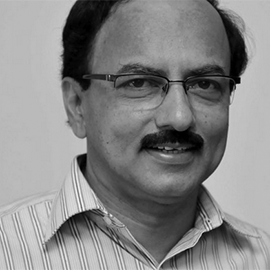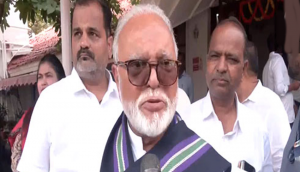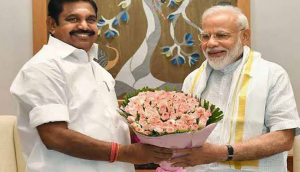Siddaramaiah's four years: steering K'taka Congress ship amid graft charges

As he completes four years in office as Chief Minister of Karnataka on 13 May, Siddaramaiah's political journey is a curious case of an 'outsider' who has turned an unshakable insider of the Congress party.
The Janata era
Hailing from the backward Kuruba community from Siddaramanahundi, a small hamlet in Mysuru district, Siddaramaiah was involved in 'anti-Congress' politics for nearly three decades, and was one of the party's bitter critics.
Getting into state Assembly for the first time on a Bharatiya Lok Dal ticket in 1983, he later joined the 'Janata Parivar' and became a minister in the Ramakrishna Hegde cabinet.
An eloquent speaker, who earned reputation as a good administrator handling sericulture, animal husbandry, transport and finance at various stages, he staked his claim for chief ministership in 1994. But, he was pipped to the post by HD Deve Gowda, reluctantly taking up the finance ministry under him.
In 1996, when Deve Gowda suddenly became the darling of smaller national parties and became the Prime Minister of the country, Siddaramaiah fancied his chances of succeeding Gowda in the state.
But, Gowda, who had ousted Hegde from the Janata Dal by then, preferred to back JH Patel, and Siddaramaiah had to be content being Deputy Chief Minister, again with finance portfolio.
When the Janata Dal split into three factions after Hegde's expulsion, Siddaramaiah preferred to go with Gowda's JD(S), and lost his election to the Assembly in 1999.
In 2004, Siddaramaiah was one of the star campaigners for the JD(S), and the Congress, under SM Krishna, suffered a humiliating defeat. Gowda persuaded Sonia Gandhi to form a Congress-JD(S) coalition government – the first for Karnataka – headed by Dharam Singh, and again, Siddaramaiah had to be content being Deputy Chief Minister.
Gowda's son HD Kumaraswamy plotted to bring down the Dharam Singh government just 20 months later, and held secret negotiations with the BJP. Gowda made the Congress believe that he would never go with the 'communal' party, and would soon expel his son and other legislators from the party.
But, Kumaraswamy struck a '20-20' deal with the BJP (that he would hand over chief ministership to the BJP after 20 months) and became one of the youngest Chief Ministers of Karnataka, of course, with his father's blessings.
Siddaramaiah was again left high and dry. A frustrated Siddaramaiah defied Gowda and began organising the backward classes in the name of 'Ahinda' (a Kannada acronym for scheduled castes, backward castes and minorities) and he was thrown out of the JD(S).
Becoming the Congress's go-to man
When Siddaramaiah knocked on the doors of the Congress for the first time in 2006, the Congress quickly welcomed him, seeing an opportunity to avenge the humiliation it had suffered at the hands of the JD(S).
When Siddaramaiah contested a by-election in December 2006, several forces ganged up against him: Congressmen unhappy with his entry to the party, Gowda seeking revenge, and Yeddyurappa out to scuttle the prospects of a potential leader.
Siddaramaiah barely scraped through by 257 votes. That was a crucial turning point of his career, as a defeat then would perhaps have sent him into oblivion. He slowly began to establish himself in the Congress and started cultivating leaders in New Delhi.
After the Congress lost again in 2008 under Mallikarjun Kharge's leadership and the BJP came to power in Karnataka, Siddaramaiah convinced Sonia and Rahul Gandhi that the Congress had to regain its core vote bank of Scheduled Castes, backward classes and minorities, who had stood by the party for over four decades. Siddaramaiah was given the reins to lead the party.
When the 2013 elections arrived, Siddaramaiah led from the front, even as other senior leaders did not join hands with him. He addressed hundreds of meetings, consolidating the backward classes and minorities behind him. The Congress obtained a clear majority with 123 seats, and Siddaramaiah became the natural choice for chief ministership.
What he could not achieve being in the 'Opposition' for 34 years, he had done so just seven years after joining the Congress.
Four years in power
There was a lot of hope and hype when he assumed office, because he was seen as someone who had followed in the footsteps of Devaraj Urs and Ramakrishna Hegde, and he had earned reputation as a good administrator.
But, over the last four years, his administration has been a mixed bag of old socialist-style freebies for the poor, placating various caste groups through celebration of 'jayanthis', emphasis on cash-churning mega projects like the steel bridge, the Yettinahole irrigation project etc rather than bringing Karnataka and Bengaluru back on the path of development.
The image of Bengaluru has suffered the most under his administration, as the Garden City has become Garbage City.
Siddaramaiah took office saying he will be give a 'transparent and corruption-free government'. But, he allowed the Lokayukta, which had a great record of tackling the corrupt officials and politicians in the state, to rot under Justice Y Bhaskar Rao, whose son was running an extortion racket. The Chief Minister later almost tried to wind up Lokayukta and replace it with an anti-corruption bureau under his direct control.
The infamous Govindaraju diary, which allegedly showed the Siddaramaiah government handing over Rs 600 crore 'retainership' to the party high command, perhaps indicated how a former firebrand politician had been 'tamed' by the Congress in its age-old ways.
The state BJP's attack on the scandals of the Siddaramaiah government has been more than overshadowed by the internal fight between its two senior-most leaders, BS Yeddyurappa and KS Eshwarappa, and there are sections which believe that the Congress has a hand in Eshwarappa's rebellion.
The two recent by-elections at Nanjangud and Gundlupet were crucial for Siddaramaiah. Wallowing in BJP's stupendous performance in Uttar Pradesh, the state BJP leaders thought they will roll over the Congress, but they failed to reckon with Siddaramaiah's tactical plans. In both places, the Congress not only ensured that the JD(S) would stay away from the contest, but in Nanjangud, lent its 'winning' candidate to the Congress. The BJP suffered a rout in both constituencies, which helped Siddaramaiah's stock to go up with the party high command.
Looking ahead
Over the years, Siddaramaiah has established a complete stranglehold over the Karnataka Congress, so much so that the other senior leaders like Kharge, Veerappa Moily, Janardhana Poojary and CK Jaffar Sharief have little say.
The JD(S) is apparently ready for an alliance or a tacit understanding with the Congress in the 2018 Assembly elections, but the Congress leadership – with bitter memories of JD(S)'s betrayal in 2006 – has left it to Siddaramaiah to decide whether it would be prudent to go with it or contest the polls on its own.
Siddaramaiah is aware that when the Congress won in 2013, Yeddyurappa's rebel outfit KJP causing a split in Lingayat votes was a major factor, whereas Yeddyurappa is now back with the BJP. Siddaramaiah is pressing for a Lingayat leader to take over as KPCC president, to garner some of the community's votes.
There's no unanimity in the state Congress over KPCC president, but there is no doubt that given his clout, Siddaramaiah will have his way.
First published: 13 May 2017, 16:21 IST






![BJP's Kapil Mishra recreates Shankar Mahadevan’s ‘Breathless’ song to highlight Delhi pollution [WATCH] BJP's Kapil Mishra recreates Shankar Mahadevan’s ‘Breathless’ song to highlight Delhi pollution [WATCH]](https://images.catchnews.com/upload/2022/11/03/kapil-mishra_240884_300x172.png)

![Anupam Kher shares pictures of his toned body on 67th birthday [MUST SEE] Anupam Kher shares pictures of his toned body on 67th birthday [MUST SEE]](https://images.catchnews.com/upload/2022/03/07/Anupam_kher_231145_300x172.jpg)






